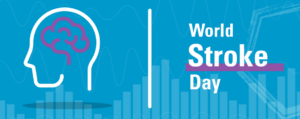A stroke can strike at any moment to anyone of any age. According to the World Stroke Organization, 1 in 4 adults will have a stroke in their lifetime. Stroke is a leading cause of death and disability worldwide, but almost all strokes can be prevented.
 The World Stroke Organization created World Stroke Day on October 29 to underscore the serious nature and high rates of stroke, raise awareness of the prevention and treatment of the condition, and ensure better care and support for survivors.
The World Stroke Organization created World Stroke Day on October 29 to underscore the serious nature and high rates of stroke, raise awareness of the prevention and treatment of the condition, and ensure better care and support for survivors.
Stroke statistics are staggering. In 2020, more than 13 million people will have a stroke, and 5.5 million people will die from a stroke.
What is a stroke?
A stroke happens when the blood supply to part of the brain is cut off. Without blood, brain cells can be damaged or die.
A clot in an artery supplies blood to the brain, a situation known as ischemia. A burst vessel causes blood to leak into the brain (a hemorrhage) leading to a stroke.
Stroke can cause permanent damage, including partial paralysis and impairment in speech, comprehension and memory. The extent and location of the damage determines the severity of the stroke, which can range from minimal to catastrophic.
Lower your odds for a stroke
Atherosclerosis, or hardening of the arteries, is one of the main causes leading to a stroke. This disease can also lead to heart attacks. Often, heart attacks and strokes go hand-in-hand, and the risk factors are similar for both.
The incidence of stroke increases significantly with age. There are many other risk factors hypertension, atrial fibrillation, higher cholesterol and obesity. Men tend to have more strokes. Genes, too, can play a role in making someone prone to stroke along with psychological factors like stress and depression.
But you can play a vital role in your well-being and risks for stroke.
- Diet: Reduce salt and sugars. Say goodbye to high-cholesterol foods (burgers, cheese, ice cream and junk food). Say hello to 4-5 cups of fruit and vegetables daily; one serving of fish two or three times a week; add more whole grains and choose low-fat dairy.
- Exercise: Get 30 minutes of activity at least five times a week.
- Smoking: Quit. Find out if your health plan covers smoking cessation programs.
- Alcohol: Limit your drinking. (One glass of alcohol a day, or none)
- Weight: Even losing 10 pounds makes a difference.
Know the signs
According to the Centers for Disease Control and Prevention, stroke symptoms can be unusual and come on suddenly. Call 911 or go to the nearest emergency room if you or someone you’re with has these unexplained, sudden warning signs:
- A feeling of numbness or weakness in your face, arm, or leg (You might notice it on one side more than the other.)
- Vision problems in one or both eyes
- Dizziness or loss of balance; difficulty walking
- Confusion
- Problems speaking or understanding what other people are saying
- Severe headaches without warning or explanation
- Neck, jaw, shoulder, upper back or abdominal discomfort
- Shortness of breath
- Pain in one or both arms
- Nausea or vomiting
- Sweating
- Lightheadedness or dizziness
- Unusual fatigue
Women can have these same symptoms, but many women who have strokes also may have these symptoms:
- Pains in the face or legs
- Hiccups
- Nausea
- Feeling weak all over
- Chest pain
- Shortness of breath
- Rapid heartbeat
The easiest way to remember symptoms for stroke is the acronym FAST:
Facial drooping
Arm weakness
Speech difficulties
Time: If you see the other symptoms, get help fast!
Getting Treatment Fast
Time is of the essence in treating stroke. According to the American Stroke Association stroke treatments and survival rates have improved greatly in the past decade thanks to medical advancements. One treatment includes a tissue plasminogen activator, which can dissolve the clot and improve blood flow.
Having a stroke doesn’t have to be fatal. There are about 80 million survivors in the world. Remembering the FAST signs of a stroke and seeking medical attention immediately could increase your survival odds.

